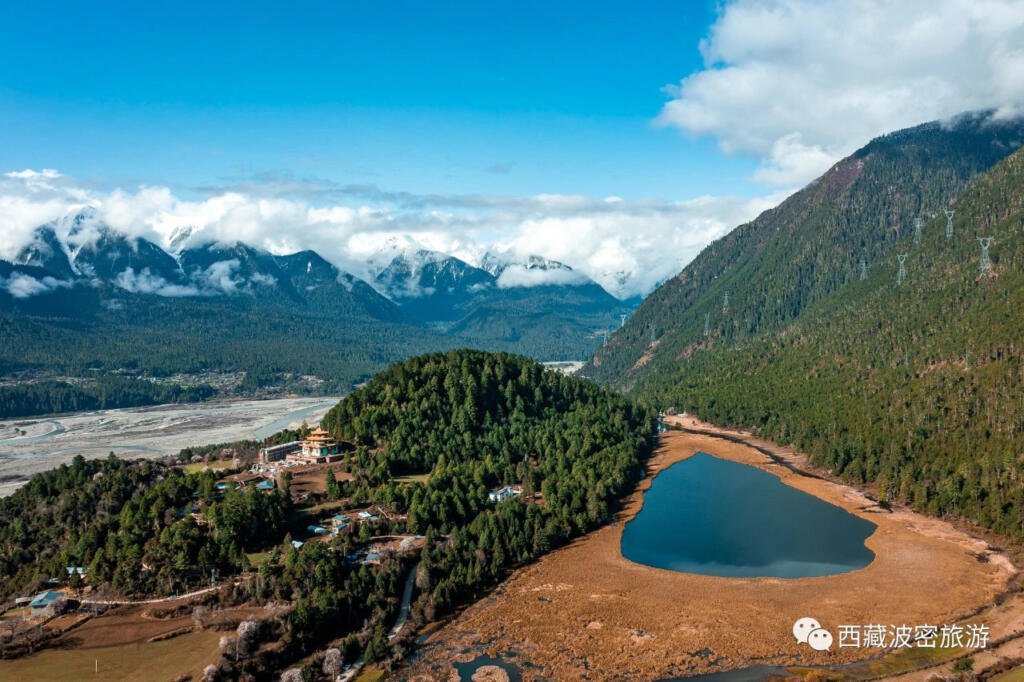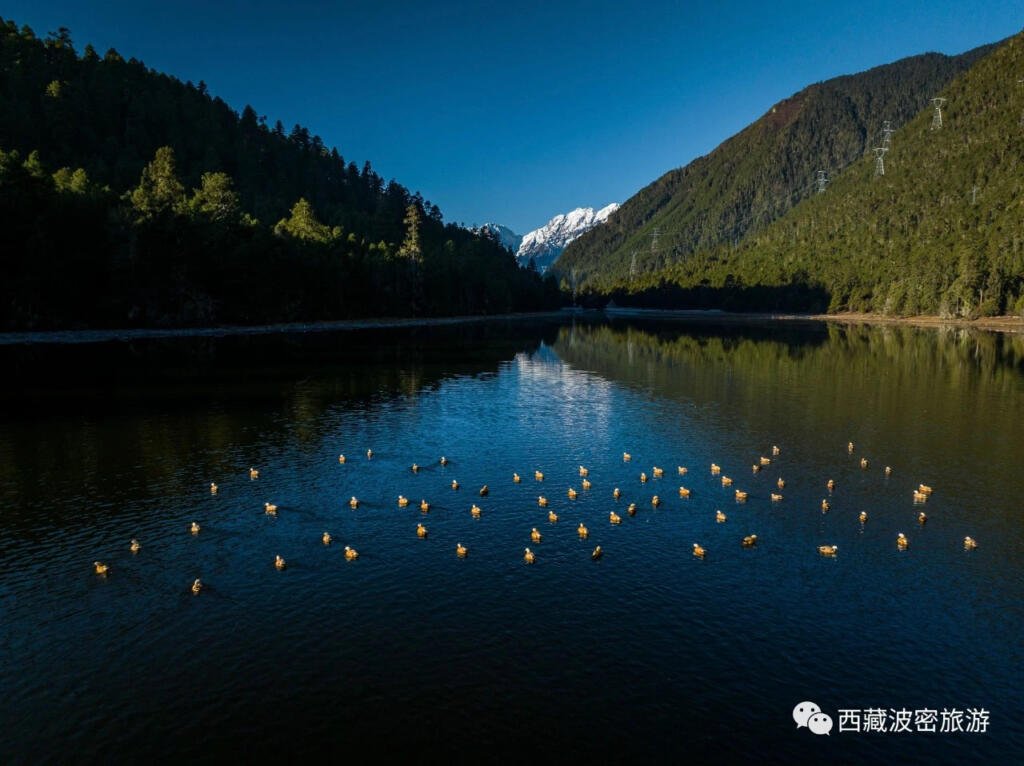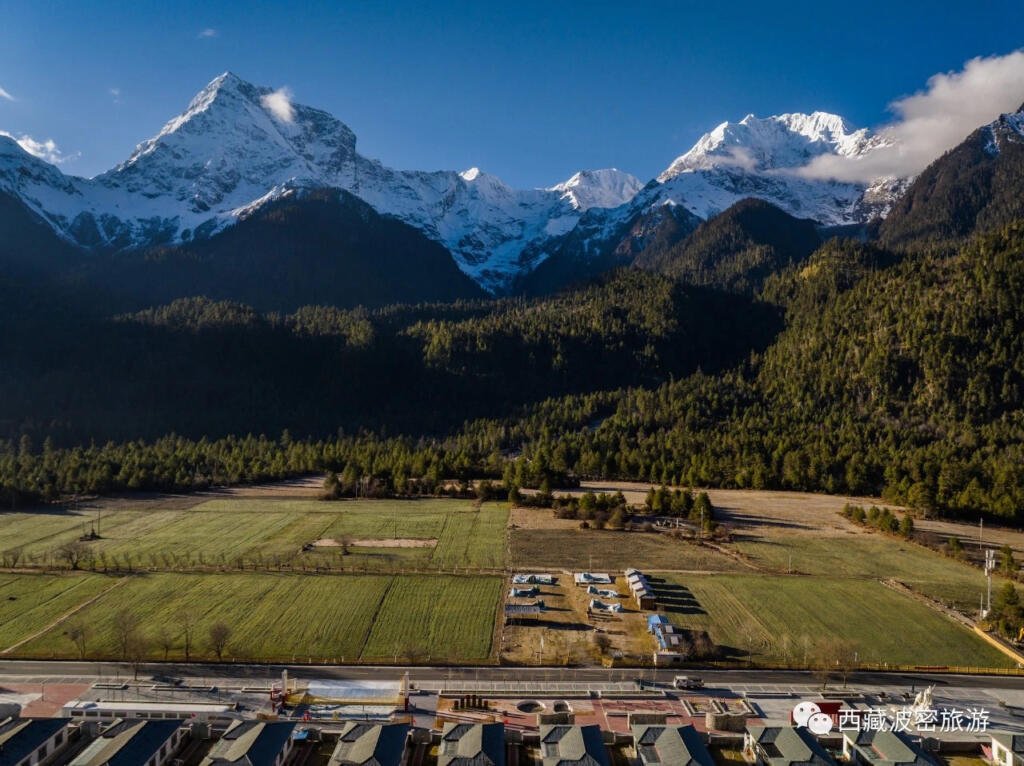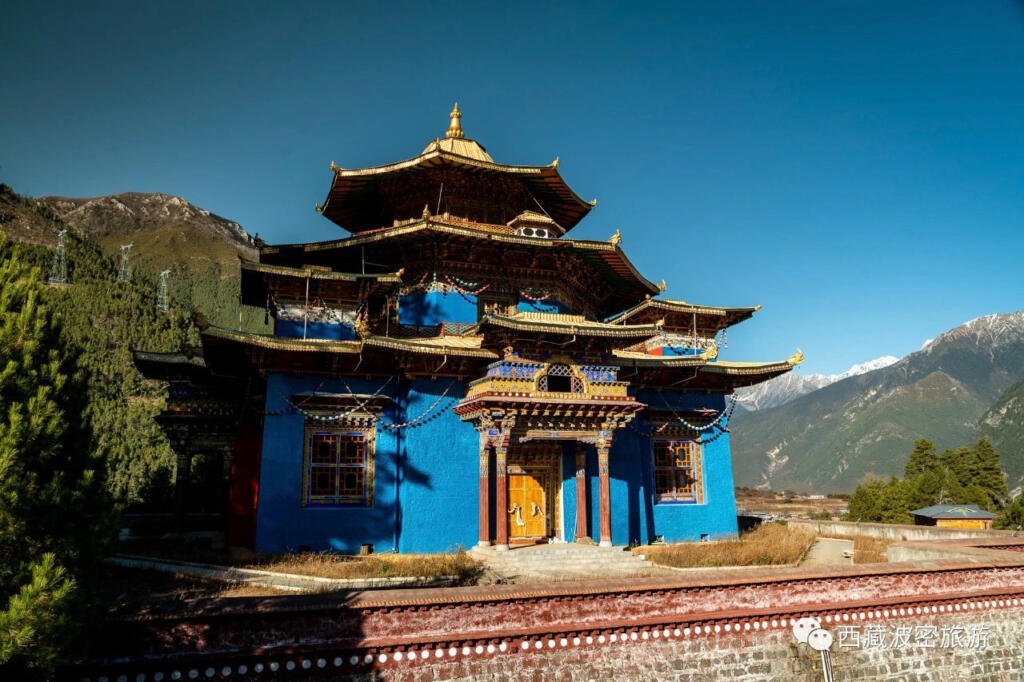Introduction to Bomê County
Nestled in the southeastern part of Tibet, along the eastern banks of the Yarlung Tsangpo River, Pome County (Tibetan: སྤོ་མེས་རྫོང) is a remarkable region with a rich history and diverse climate. It spans from 29.4° to 30.7° North latitude and 94.0° to 96.8° East longitude.
Hidden within the heart of the Himalayan wilderness lies the enigmatic kingdom of Bomê. The isolation of the area deepened its mystery, as many Tibetans believed it to be one of the ‘hidden lands’ or beyul, as predicted in the prophecies of Guru Rinpoche. Pome’s influence extended far beyond the borders of Bomê County, acting as a protective sanctuary for Tibetan pilgrims in search of the Promised Land in the East Himalayas, safeguarding them from the Lopa tribes of Assam Himalayas since the mid-seventeenth century.
Historical Significance of Bomi County
In Tibetan, “Bomê” signifies “ancestors land” Historically known by various names like Po-wo (波密县). It once was the site of the ancient Bomi Kingdom established by King Kanam Depa. By 1931, the Lhasa government had ousted the last Kanam depa and established two garrisons, marking the end of an era for this mystical kingdom. In 1954, Bomi was formed by uniting the three regions of Chuzong, Yigong, and Chingduo.
It became an official county in December 1959, with the county government based in Zhamu Town (altitude 2,720 meters). Initially under the jurisdiction of Chamdo City, it was later transferred to Nyingchi in 1986. Covering 16,748 square km, Bomi has a population of nearly 35,000 and includes 3 towns: Zhamu (སྤྲ་རྨོག་གྲོང་རྡལ།), Chumdo (ཆུ་མདོ་གྲོང་རྡལ།), and Sumzom (གསུམ་འཛོམས་གྲོང་རྡལ།), 7 townships, 84 administrative villages, and 1 community.

Geography and Climate of Bomi County
Mountainous terrain and hills characterize Bomi County, with the valleys of the Palong Tsangpo and Yigong Tsangpo rivers at its center, surrounded by mountains. The topography is higher in the east and lower in the west, with the highest point reaching 6,648 meters and the lowest at 2,001.4 meters. The average altitude is around 4,200 meters.
Eastern Tibetan Pome is renowned for its unique local products; such as Gusha honey, Dorchen butter, and Soton Sichuan pepper. These are all trademarked specialties. emperate semi-humid plateau monsoon zone. Areas below 2,700 meters experience a subtropical climate, while regions between 2,700 and 4,200 meters enjoy a temperate, semi-humid plateau climate. Above 4,200 meters, it’s a cold, wet plateau climate zone. Bomê has an average annual temperature of 8.5°C, abundant rainfall, about 1,563 hours of sunshine per year, a frost-free period of 176 days, and an average annual precipitation of 977 millimeters.

Bomi County’s Rich Agricultural Heritage
Located in Southeastern Tibet, Bomi County is not only one of the 11 major grain-producing counties in Tibet. It is also crucial source of export-quality mushrooms such as Matsutake and Morchella. It recognized as a “National Safe and Advanced County,” “National Cultural Advanced County,” and “National Civilized County Town. Pome County has made remarkable strides in agriculture and culture, even exiting the poverty list in October 2018.
Bomê’s Diverse Agriculture and Livestock
Bomi County’s agriculture boasts an array of crops like highland barley, wheat, and peas. Its livestock includes yaks, dzo (yak-cattle hybrids), and sheep. The county is also rich in minerals like copper, iron, tungsten, molybdenum, and placer gold.
Specialty Products of Bomi County
Pome is renowned for its unique local products, including Gusha honey, Dorchen butter, and Soton Sichuan pepper, all trademarked specialties. The region also produces lacquer trees, walnuts, mulberry trees, and apples. Medicinal plants such as Gastrodia elata, Panax notoginseng, Hericium erinaceus, and Poria cocos thrive here. The Yigong Tibetan knives, known since ancient times, and the regionally famous “Zhumu Tea” are also highlights of Bomi’s rich product range.

FAQs on Bomi’s Specialty Products
Q: What is Gastrodia elata and its significance in Bomê?
Locally known as “Dorpen,” Gastrodia elata is a valued medicinal herb. As a saprophytic perennial herb, it lacks chlorophyll and features fleshy tubers underground. Traditional Tibetan medicine uses it for treating dizziness, headaches, facial paralysis, and convulsions. It also has calming effects and serves in treating high blood pressure and concussions.
A: The Lacquer Tree is a deciduous tree that can grow up to 20 meters tall and contains a milky sap. Its leaves are pinnate, and it blooms in early summer with yellow-green flowers. The natural lacquer extracted from it provides a hard, glossy finish and excellent sealing properties. The fine-textured wood suits carpentry well, and its fruits yield lacquer wax, while people use the seeds for oil extraction.
Q: What makes Bomi’s Tibetan knives and Zhumu Tea special?
Bomi’s Yigong Tibetan knives have earned renown for their quality and craftsmanship, a tradition spanning centuries. Likewise, people celebrate Zhumu Tea both regionally and beyond for its unique flavor and quality, representing the area’s rich cultural heritage.

Exploring Bomi County, Tibet: A Blend of Natural Beauty and Unique Products
Bomê County: A Hub of Agriculture and Specialties
Nestled in southeastern Tibet, Bomê County stands out not only as one of Tibet’s eleven key grain-producing areas but also as a major source of export-quality mushrooms like Matsutake and Morels. Bomi has earned accolades such as “National Safe and Advanced County” and “National Cultural Advanced County,” marking its exit from poverty in October 2018.
Bomi’s Rich Agricultural and Livestock Profile
This county’s agricultural prowess is evidenced in its diverse crops, including highland barley, wheat, and peas, and its thriving livestock of yaks, dzo, and sheep. Bomi is also mineral-rich, with resources like copper, iron, tungsten, molybdenum, and placer gold.
Specialty Products from Bomê County
Bomi’s fame extends to its specialty products like Gu Xiang honey, Duo Ji butter, and Suo Tong Sichuan pepper (all registered trademarks), as well as lacquer trees, walnuts, mulberry trees, and apples. The county’s medicinal plants include Gastrodia elata, Panax notoginseng, Hericium erinaceus, and Poria cocos. The Yigong Tibetan knives, known for their quality and craftsmanship, and the renowned “Zhumu Tea” are cultural highlights of Bomê.
FAQs on Bomê County’s Specialties
Q: What are the medicinal properties of Poria cocos found in Bomi?
A: Poria cocos, also known as Fu Ling, is a cherished medicinal fungus in Bomi. It grows on pine roots and is used in traditional medicine for its mild, sweet properties. It benefits the spleen, calms the mind, and facilitates water metabolism. According to Li Shizhen’s “Compendium of Materia Medica,” long-term consumption of Fu Ling can nourish the spirit, prolong life, and treat conditions like dizziness, insomnia, edema, and urinary difficulties.
Q: What makes the Yigong Tibetan Knife unique?
Locally known as “Pudri Gyama,” craftsmen create the Yigong Tibetan Knife using a combination of three local iron ores. Renowned for its length, sharpness, and durability, the upper class of Bomê historically used the knife. Its unique manufacturing process, reflecting the rich cultural heritage of the Yigong iron mines, makes it an essential aspect of Tibetan cultural research.
Tourist Attractions in Bomê County
Q: What are the must-visit natural attractions in Bomi County?
A: Bomi County boasts numerous attractions, including the beautiful Midui Glacier, the largest maritime glacier in China – the Kachin Glacier, the pristine Gangxiang Nature Reserve, the world’s third-largest canyon – the Palong Tsangpo Canyon, and the scenic Sichuan-Tibet Highway. The Yigong National Geology Park is Tibet’s first national geological park.
Travel Tips for Bomê County
- Six-Day Bomi Tour: Explore from Chengdu to Linzhi, enjoy the Yarlung Tsangpo River scenic area, and visit natural wonders like Midui Glacier and Ranwu.
- Unique Cultural Practices: Don’t miss the traditional “tree burial” in Zhuolonggou, just 6 km from Bomi County, and the famous Bomi Daxi Village Bear Festival.
- Seasonal Travel Advice: The best time to visit is during spring (March-April) for blooming flowers. Prepare for potential landslides during the rainy season (July-August). Carry essentials like hiking shoes, ID, and necessary permits for border areas.
- Culinary and Accommodation: Enjoy Tibetan cuisine and comfortable accommodations in Bomê, ensuring a memorable stay.
Travel Guide to Bomê County: Navigating Transportation, Food, Accommodation, and Local Culture
Getting to and Around Bomi County
Bomi County, enriched with natural beauty, is well-connected by major transportation routes. The main artery is the Sichuan-Tibet Highway (National Highway 318), stretching over 200 kilometers within the county. With additional rural roads spanning over 140 kilometers, the county is 230 kilometers from Linzhi’s Nyingchi Mainling Airport and 636 kilometers from Tibet’s capital, Lhasa. To the east, it’s about 1,500 kilometers to Chengdu, and access to Kunming via the Dian-Tibet Highway through Markham is also available. This network makes Bomê a crucial transit point for tourists traveling through the Sichuan-Tibet and Yunnan-Tibet routes.
Travel Tips for Bomê County Visitors
Transportation Options
- By Air: Fly to Nyingchi Mainling Airport and take a bus to Bomi from Nyingchi.
- By Road: Direct bus services from Chengdu, or buses from Lhasa passing through Bomi.
- From Yunnan: Take a bus from Lijiang to Lhasa via Bomi. Bomê is a significant hub on the scenic 318 Highway route.
Culinary Delights
- Local specialties include air-dried beef, barley cakes, fried dough, and yogurt.
- Must-try dishes: Chicken stewed with Gastrodia elata, grilled Tibetan pork, Cordyceps duck soup, Matsutake and Cordyceps rib soup, and Zhamu fish.
Accommodation
- Bomi offers over 40 hotels and restaurants, providing clean and comfortable lodging.
- Opt for family-run guesthouses or Tibetan-style homestays for an authentic experience, complete with Tibetan cuisine at reasonable prices.
Cultural and Recreational Activities
- Enjoy horseback glacier tours, Songzong Horse Racing Festival, Yigong Rapeseed Flower Festival, Xiba Bear Fighting Festival, and Dadha Horse Racing Festival.
- Local dances and songs like the Bodro (Bomê local dance), Boyang (singing without dancing), and other regional performances.
Souvenirs and Local Products
- Popular souvenirs include Yigong Tibetan knives, wooden bowls, and Tibetan-style furniture.
- During summer, locals often sell local products like Gastrodia elata, Matsutake, Lingzhi mushrooms, Morels, Cordyceps, Saffron, Hericium mushrooms, and Green Mold roadside. Shoppers can buy or barter these items, offering a unique shopping experience.
Exploring Bomê County
Bomi County is not just a travel destination but an experience of Tibetan culture, natural wonders, and culinary delights. Whether you’re traveling by road or air, staying in local guesthouses, indulging in traditional foods, or participating in cultural festivals, Bomê offers an unforgettable journey into the heart of Tibet.

